
|
Astronomy Picture Of the Day (APOD)
 Andromedas Core
Andromedas Core
26.12.2004
The center of the Andromeda galaxy is beautiful but strange. Andromeda, indexed as M31, is so close to our own Milky Way Galaxy that it gives a unique perspective into galaxy composition by allowing us to see into its core.
 GRO J165540: Evidence for a Spinning Black Hole
GRO J165540: Evidence for a Spinning Black Hole
25.12.2004
In the center of a swirling whirlpool of hot gas is likely a beast that has never been seen directly: a black hole. Studies of the bright light emitted by the swirling gas frequently indicate not only that a black hole is present, but also likely attributes.
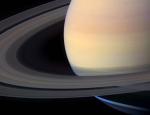 Big Beautiful Saturn
Big Beautiful Saturn
24.12.2004
As a present to APOD readers, digital imager Mattias Malmer offers a very high resolution view of big beautiful Saturn. A labor of love, his full mosaic, composite image is contained in a large 5 megabyte jpeg file (preview here, download here) and spans the gorgeous gas giant from ring tip to ring tip.
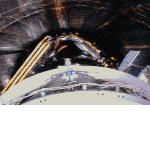 Swift RocketCam
Swift RocketCam
23.12.2004
A forward-facing RocketCam (TM) mounted inside the payload fairing of a Delta II rocket captured these dramatic video frames on November 20th -- as the Swift satellite observatory journeyed to an orbit 600 kilometers above planet Earth. Some frames were interpolated to correct for transmission problems.
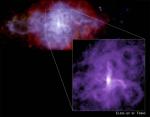 3C58: Pulsar Power
3C58: Pulsar Power
22.12.2004
Light from a star that exploded some ten thousand light-years away first reached our fair planet in the year 1181. Now known as supernova remnant 3C58, the region seen in this false-color image glows in x-rays, powered by a rapidly spinning neutron star or pulsar - the dense remains of the collapsed stellar core.
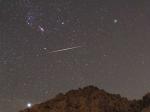 Comet, Meteor, Nebula, Star
Comet, Meteor, Nebula, Star
21.12.2004
Several wonders of the late-year northern sky appeared together for a few fleeting moments on December 13. On the bottom left, just above the hill, is blue Sirius, the brightest star in the sky.
 Titan Disguised
Titan Disguised
20.12.2004
Will the Huygens probe land or splash down? In the next few days, the Cassini spacecraft currently orbiting Saturn will release a probe that will descend toward Saturn's largest moon in mid-January. That moon, Titan, has a surface normally hidden from view by thick methane cloud decks.
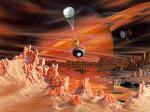 Titan Surmised
Titan Surmised
19.12.2004
What does the surface of Titan look like? Thick clouds have always made Saturn's largest moon so mysterious that seemingly farfetched hypotheses like methane rain and lakes have been seriously considered. Later this...
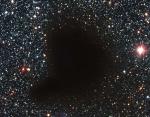 Molecular Cloud Barnard 68
Molecular Cloud Barnard 68
18.12.2004
Where did all the stars go? What used to be considered a hole in the sky is now known to astronomers as a dark molecular cloud. Here, a high concentration of dust and molecular gas absorb practically all the visible light emitted from background stars.
 Europa: Ice Line
Europa: Ice Line
17.12.2004
This bright white swath cutting across the surface of icy Jovian moon Europa is known as Agenor Linea. In all about 1000 kilometers long and 5 kilometers wide, only a section is pictured here as part of a combined color and black and white image based on data from the Galileo spacecraft.
|
January February March April May |
|||||||||||||||||||||||||||||||||||||||||||||||||